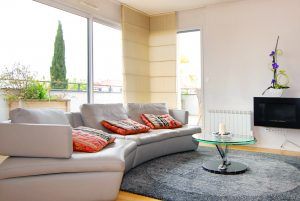

The length depends on your apartment’s status : main dwelling or secondary residence.
Maximum duration of a seasonal rental for a principal residence
An owner can rent out their main residence for seasonal rental if he meets these 4 criteria:
- The rented accommodation is for the exclusive use of the tenant (no owner presence in the premises)
- The tenant stays there for a short time (daily, weekly or monthly rental)
- The tenant does not take up residence there
- The accommodation can be rented for a maximum period of 90 days per tenant and for a total period of 120 days per calendar year (in case the tenant changes). NB: this 120-day limit is not applied in all municipalities.
The main residence is the place usually occupied by one or more people from the same household. Knowing a person’s place of main residence is sociological information, allowing a person to be located in their social environment. But this is of great interest to the civil and military authorities: knowing the main place of a person’s life allows certain taxes to be determined, opens the right to registration on the electoral rolls and serves as a domicile.
The choice of primary residence is an important tax decision for every taxpayer.
Couples will have to choose a common place of residence, and will be able to explore all the possibilities of tax deductions such as expenses related to the residence and its location. In addition to the actual costs, the choice of primary residence may or may not qualify for tax credits for environmental and personal assistance expenses, or for loan interest.
If the owners decide to rent out their main residence occasionally to a passing clientele and for its exclusive use during their holidays for example, the law has imposed strict rules as to the 120-day limit per year, for example.
Maximum duration of a seasonal rental for a secondary residence
As for renting out a secondary residence, there is no annual limit for seasonal rental as long as the owner has taken the necessary steps to legalize the housing status.
Here is some important information to understand the type of secondary residence and the regulations in terms of occupancy.
According to INSEE, the main residence is the place in which the occupant lives 6 to 8 months a year. (There is a difference between the tax definition of a main residence and the definition for civil authorities).
All other real estate is considered secondary.
This therefore includes on the one hand holiday homes, but also rental investments, or vacant housing (housing that belongs to you and is currently unused).
Holiday home
The secondary residence is a dwelling used in particular as a holiday accommodation for its owners or tenants. They only reside there for short periods during the year (holidays, weekends, leisure activities, etc.). In this, it differs from the main residence, which is the household’s usual accommodation.
According to INSEE, only around 13% of French people own a second home.
On the other hand, the owners may not occupy their second home and may rent it out instead.
Entrusting an agency such as Urban Sejour with the rental management of your secondary residence may be the best solution for managing the premises.
Some owners have studios, apartments or houses but which remain unoccupied for long months or even years. In addition to the cost of the high monthly charges, these owners could find themselves in problematic situations if the lodging suffered a disaster and due to its vacancy, and the damage was not noticed and / or repaired in time.
Offering your flat for temporary rental through Urban Sejour remains a perfect solution to avoid such situations. Our agency does not only offer accommodations in downtown Lyon. We also offer housings in the municipalities of the Grand Lyon area such as Villeurbanne, Bron, Ecully, Decines, Genas…
